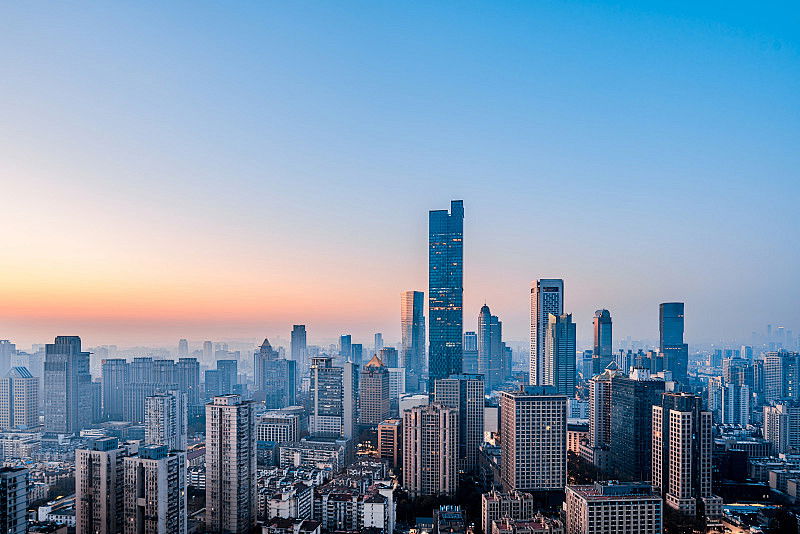Le matériau derrière le verre des gratte-ciel : un mélange de résistance, de sécurité et d'innovation

1. The Core Requirement for Skyscraper Glass: Beyond Transparency
Skyscraper glass must withstand extreme conditions—high wind loads, temperature fluctuations, potential impacts, and even seismic activity—while balancing energy efficiency, aesthetics, and occupant comfort. Unlike ordinary window glass, its design is a feat of engineering, often combining multiple materials and technologies.
2. Primary Glass Types Used in Skyscrapers
a. Tempered Glass: Engineered for Durability
Tempered glass (also called "toughened glass") is a cornerstone of skyscraper construction. Made by heating ordinary float glass to ~650°C and rapidly cooling it, this process induces compressive stress on the surface and tensile stress in the core, making it 4–5 times stronger than annealed glass. If broken, it shatters into small, harmless pieces (rather than sharp shards), reducing safety risks—a critical feature for high-rise buildings where falling glass could be deadly.
Example: The Burj Khalifa in Dubai uses laminated tempered glass to withstand desert heat and high winds.
b. Laminated Glass: Safety Through Layers
Laminated glass consists of two or more glass panes bonded with an interlayer (typically polyvinyl butyral, or PVB). This design enhances impact resistance: even if the glass breaks, the interlayer holds shards together, preventing collapse. It also improves sound insulation and blocks ultraviolet (UV) rays, protecting interior furnishings.
Application: In hurricane-prone regions, skyscrapers like Miami’s Brickell City Centre use hurricane-resistant laminated glass to endure storm-force winds.
c. Insulated Glass Units (IGUs): Balancing Energy Efficiency
IGUs comprise two or more glass panes separated by a vacuum or gas-filled space (often argon or krypton). The airtight seal reduces heat transfer, minimizing cooling/heating costs—a crucial factor for skyscrapers, which consume vast energy. Coating the glass with low-emissivity (Low-E) films further enhances thermal performance by reflecting infrared radiation.
Case Study: The Shard in London uses triple-glazed IGUs with Low-E coatings, reducing heat loss by up to 70%.
3. Advanced Coatings and Treatments: Tailoring Performance
- Low-E Coatings: Thin metal or ceramic layers that reflect heat while allowing visible light through, ideal for maintaining indoor comfort in both hot and cold climates.
- Solar Control Coatings: These reduce solar heat gain, preventing overheating in sunny regions. They may tint the glass (e.g., blue or green) or use reflective materials to balance light and heat.
- Self-Cleaning Glass: Coated with titanium dioxide, which breaks down dirt via sunlight and reacts with water to form a hydrophilic layer, causing rain to wash away grime. This is common in skyscrapers like the Salesforce Tower in San Francisco.
4. Specialized Materials for Unique Challenges
- Bulletproof/Explosion-Resistant Glass: Laminated with thicker interlayers (e.g., polycarbonate) to withstand ballistic impacts or blasts, used in government buildings or high-security skyscrapers.
- Smart Glass: Electrochromic or thermochromic materials that switch from transparent to opaque with electricity or temperature changes, enabling dynamic light control (e.g., the Apple Park campus uses smart glass for adjustable privacy).
- Photovoltaic Glass: Integrated with solar cells to generate electricity, turning windows into energy sources. While less common, projects like the Shanghai Tower experiment with this sustainable technology.
5. The Future: Innovations in Skyscraper Glass
As sustainability and smart technology gain priority, materials like:
- Thin-Film Perovskite Solar Glass: Lightweight and flexible, potentially integrating solar power into facades.
- Nano-Coated Glass: Using nanomaterials to enhance durability, self-cleaning, or UV resistance.
- 3D-Printed Glass Components: Enabling complex architectural designs while maintaining structural integrity.
6. Conclusion: The Evolution of a Structural Marvel
Skyscraper glass is no longer just a window—it’s a composite system designed for strength, safety, energy efficiency, and innovation. From tempered and laminated bases to smart and solar-integrated surfaces, each material choice reflects a balance of engineering rigor and architectural vision, shaping the skyline while protecting those within. As cities grow taller, the glass that envelopes them will continue to evolve, pushing the boundaries of what construction materials can achieve.



